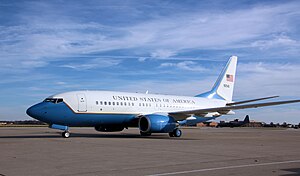932nd Airlift Wing
932d Airlift Wing
 |
|
|---|---|

932d Airlift Wing Boeing C-40C Clipper 09-0540
|
|
| Active | 1963—present |
| Country |
|
| Branch |
|
| Type | Wing |
| Role | Distinguished Visitor Airlift |
| Size | 1,100 Personnel |
| Part of |
|
| Garrison/HQ | Scott Air Force Base, Illinois |
| Decorations |
Air Force Outstanding Unit Award Republic of Vietnam Gallantry Cross with Palm |
| Commanders | |
| Current commander |
Colonel Karl E. Goerke |
| Insignia | |
| 932d Airlift Wing emblem (approved 5 June 1995) |  |
| Aircraft flown | |
| Transport | C-40 Clipper |
The 932d Airlift Wing is an Air Reserve Component of the United States Air Force. It is assigned to the Twenty-Second Air Force, Air Force Reserve Command, stationed at Scott Air Force Base, Illinois.
The 932d is an associate unit of the 375th Air Mobility Wing, Air Mobility Command (AMC) and if mobilized the wing is gained by AMC.
The 932d Airlift Wing provides first-class, worldwide, safe, and reliable airlift for distinguished visitors and their staffs. The wing maintains aircraft for special assignment missions. It equips, trains and organizes a ready force of Citizen Airmen to support and maintain all facets of air base operations involving infrastructure and security. The wing also provides worldwide medical services to the warfighter from the front line to the continental United States fixed medical treatment facilities.
After May 1959, the reserve flying force consisted of 45 troop carrier squadrons assigned to 15 troop carrier wings. The squadrons were not all located with their parent wings, but were spread over thirty-five Air Force, Navy and civilian airfields under what was called the Detached Squadron Concept. The concept offered several advantages. Communities were more likely to accept the smaller squadrons than the large wings and the location of separate squadrons in smaller population centers would facilitate recruiting and manning. However, under this concept, all support organizations were located with the wing headquarters. Although this was not a problem when the entire wing was called to active service, mobilizing a single flying squadron and elements to support it proved difficult. This weakness was demonstrated in the partial mobilization of reserve units during the Berlin Crisis of 1961. To resolve this, at the start of 1962, Continental Air Command, (ConAC) determined to reorganize its reserve wings by establishing groups with support elements for each of its troop carrier squadrons. This reorganization would facilitate mobilization of elements of wings in various combinations when needed.
...
Wikipedia
